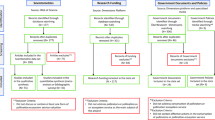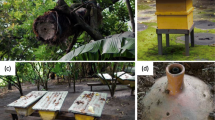Abstract
There is an increasing interest in indigenous fruit trees (IFTs) and their potential role for agroforestry, food security and poverty alleviation. Despite the growing numbers of studies on IFTs in Africa, little research has focused on the rainforest zone outside Cameroun and Nigeria. This study investigated if the important IFTs of Sierra Leone are among those previously identified as ‘priority’ species for this zone and, as they are not, a new approach combining focus-group data, field observations, a market survey and a ranking exercise was used to determine which IFTs have highest potential for agroforestry in a given area. Results indicated that the most important IFTs in Sierra Leone as established by local farmers are Parinari excelsa Sabine, Cola lateritia K. Schum., Pentaclethra macrophylla Benth., Heritiera utilis (Sprague) Sprague and Bussea occidentalis Hutch. However, following the ranking exercise, the species H. utilis, Garcinia kola Heckel and Beilschmiedia mannii (Meisn.) Benth. et Hook. f. ex B. D. Jacks., highly appreciated by locals, already managed by some farmers and reported ‘difficult to find in the wild’, were found to have the highest potential for agroforestry in the country. The findings highlighted that previous IFTs prioritization in Cameroun and Nigeria were not representative of the whole African rainforest zone. A new approach was successfully used to identify the IFTs with greatest potential for agroforestry in Sierra Leone. This simple cost-effective approach, which straightforwardly identifies opportunities and challenges for each species, could be used elsewhere in the tropics to establish a baseline for future domestication programs.

Similar content being viewed by others
References
Adam KA (2005) Heritiera utilis (Sprague) Sprague. [Internet] Record from Protabase. In: Louppe D, Oteng-Amoako AA, Brink M (eds) PROTA, Wageningen, Netherlands. <http://www.prota4u.org/search.asp>. Accessed 22 Sept 2015
Akinnifesi FK, Leakey RRB, Ajayi O, Sileshi G, Tchoundjeu Z, Matakala P et al (2008) Indigenous fruit trees in the tropics: domestication, utilization and commercialization. CABI, Wallingford
Assogbadjo AE, Glèlè Kakaï R, Vodouhê FG, Djagoun CAMS, Codjia JTC, Sinsin B (2012) Biodiversity and socioeconomic factors supporting farmers’ choice of wild edible trees in the agroforestry systems of Benin (West Africa). Forest Pol Econ 14:41–49
Atangana AR, Van der Vlis E, Khasa DP, Van Houten D, Beaulieu J, Hendrick H (2011) Tree-to-tree variation in stearic and oleic acid content in seed fat from Allanblackia floribunda from wild stands: potential for tree breeding. Food Chem 126:1579–1585
Brehm JM, Maxted N, Martins-Loucao MA, Ford-Lloyd BV (2010) New approaches for establishing conservation priorities for socio-economically important plant species. Biodivers Conserv 19:2715–2740
Boateng SK, Yeboah AE, Amponsah JY (2007) Wet season collection of edible wild fruits in three regions of Ghana. J Plant Sci 2:353–357
Boffa JM (1999) Agroforestry parklands in sub-Saharan Africa. FAO, Rome
Brink M (2007) Cola lateritia K. Schum. In: Louppe D, Oteng-Amoako AA, Brink M (eds) Prota 7(1): Timbers/Bois d’œuvre 1. [CD-Rom]. PROTA, Wageningen, Netherlands. <http://www.prota4u.org/search.asp>. Accessed 22 Sept 2015
Cheek M (2004) Garcinia kola. In: IUCN 2012.IUCN Red List of Threatened Species. http://www.iucnredlist.org. Accessed 22 Sept 2015
Cuni-Sanchez A, Lindsell JA (accepted) The role of remnant trees in carbon sequestration, vegetation structure and tree diversity of early succession re-growing fallows in eastern Sierra Leone. Afr J Ecol
Dawson IK, Leakey R, Clement CR, Weber JC, Cornelius JP, Roshetko JM, Vinceti B, Kalinganire A, Masters E, Jamnadass R (2014) The management of tree genetic resources and the livelihoods of rural communities in the tropics: non-timber forest products, smallholder agroforestry practices and tree commodity crops. For Ecol Manage 333:9–21
Djagbletey GD, Bosch CH (2011) Bussea occidentalis Hutch. & Dalziel. [Internet] Record from PROTA4U. In: Lemmens RHMJ, Louppe D, Oteng-Amoako AA (eds). PROTA, Wageningen, Netherlands. <http://www.prota4u.org/search.asp>. Accessed 22 Sept 2015
Franzel S, Jaenicke H, Janssen W (1996) Choosing the right trees: setting priorities for multipurpose tree improvement, International Service for National Agricultural Research (ISNAR), The Hague. Research Report No. 87pp
Gaoue OG, Ticktin T (2007) Patterns of harvesting foliage and bark from the multipurpose tree Khaya senegalensis in Benin: variation across ecological regions and its impacts on population structure. Biol Conserv 137:424–436
Gebauer J et al. (2016) Africa’s wooden elephant: the baobab tree (Adansonia digitata L.) in Sudan and Kenya—a review. Genet Resour Crop Evol 63:377–399
Harlan JR (1975) Crops and man. The American Society of Agronomy and the Crop Science Society of America, Madison
Hawthorne W (1998) Heritiera utilis. In: IUCN 2011. IUCN red list of threatened species. Version 2011.2. www.iucnredlist.org. Accessed 22 Sept 2015
Hawthorne W, Gyakari N (2006) Photoguide for the forest trees of Ghana: A tree-spotter’s field guide for identifying the largest trees. Oxford Forestry Institute, Oxford
Idohou R, Ephrem Assogbadjo AE, Fandohan B, Gouwakinnou GN, Glele Kakai RL, Sinsin B, Maxted N (2013) National inventory and prioritization of crop wild relatives: case study for Benin. Genet Resour Crop Evol 60:1337–1352
Jamnadass RH, Dawson IK, Franzel S, Leakey RRB, Mithofer D, Akinnifesi FK, Tchoundjeu Z (2011) Improving livelihoods and nutrition in sub-Saharan Africa through the promotion of indigenous and exotic fruit production in smallholders’ agroforestry systems: a review. Int For Rev 13:338–354
Jusu A, Cuni-Sanchez A (2013) Economic importance of the medicinal plant trade in Sierra Leone. Econ Bot 67:299–312
Jusu A, Cuni-Sanchez A (2014) Medicinal plant trade in Sierra Leone: threats and opportunities for conservation. Econ Bot 68:16–29
Kan Koko L, Snoeck D, Lekadou TT, Assiri AA (2013) Cacao-fruit tree intercropping effects on cocoa yield, plant vigour and light interception in Cote d’Ivoire. Agrofor Syst 87:1043–1052
Leakey RRB, Weber JC, Page T, Cornelius JP, Akinnifesi FK, Roshetko JM, Tchoundjeu Z, Jamnadass R (2012) Tree domestication in agroforestry: progress in the second decade. In: Nair PKR, Garrity D (eds) Agroforestry: the future of global land use. advances in agroforestry. Springer, The Netherlands, pp 145–173
Lindsell JA, Klop E (2013) Spatial and temporal variation of carbon stocks in a lowland tropical forest in West Africa. For Ecol Manag 289:10–17
Lowe AJ, Gillies ACM, Wilson J, Dawson IK (2000) Conservation genetics of bush mango from central/west Africa: implications from random amplified polymorphic DNA analysis. Mol Ecol 9:831–841
Muriuki J, Franzel S, Mowo J, Kariuki P, Jamnadass R (2012) Formalisation of local herbal product markets has potential to stimulate cultivation of medicinal plants by smallholder farmers in Kenya. For Trees Livelihoods 21:114–127
Myers N, Mittermeier RA, Mittermeier CG, da Fonseca GAB, Kent J (2000) Biodiversity hotspots for conservation priorities. Nature 403:853–858
Oboh G (2007) Pentaclethra macrophylla Benth. In: van der Vossen HAM, Mkamilo GS (eds) PROTA 14: vegetable oils/Oléagineux. [CD-Rom]. PROTA, Wageningen
Ofori DA, Gyau A, Dawson IK, Asaah E, Tchoundjeu Z, Jamnadass R (2014) Developing more productive African agroforestry systems and improving food and nutritional security through tree domestication. Curr Opin Environ Sustain 6:123–127
Okiror P, Agea JG, Okia CA, Okullo JBL (2012) On-farm management of Vitellaria paradoxa C. F. Gaertn. in Amuria district, eastern Uganda. Int J For Res. doi:10.1155/2012/768946
Oyen LPA (2012) Parinari excelsa Sabine. [Internet] Record from PROTA4U. In: Lemmens RHMJ, Louppe D, Oteng-Amoako AA (eds) PROTA, Wageningen, Netherlands. <http://www.prota4u.org/search.asp>. Accessed 22 Sept 2015
Pearson TRH, Brown SL, Birdsey RA (2007) Measurement guidelines for the sequestration of forest Carbon. General Technical Report NRS-18. US Department of Agriculture, Forest Service, Northern Research Station. Newton Square, Pennsylvania, US
Ræbild A, Larsen AS, Jensen JS, Ouedraogo M, De Groote S, Van Damme P, Bayala J, Diallo BO, Sanou H, Kalinganire A, Kjaer ED (2011) Advances in domestication of indigenous fruit trees in the West African Sahel. New For 41:297–315
Sop TK, Oldeland J, Bognounou F, Schmiedel U, Thiombiano A (2012) Ethnobotanical knowledge and valuation of woody plants species: a comparative analysis of three ethnic groups from the sub-Sahel of Burkina Faso. Environ Dev Sustain. doi:10.1007/s10668-012-9345-9
Tchoundjeu Z, Kengue J, Leakey RRB (2002) Domestication of Dacryodes edulis: state-of-the-art. For Trees Livelihoods 12:3–13
Tchoundjeu Z, Asaah E, Tsobeng A, Degrande A, Atia J (2013) High-value indigenous fruit trees contribution to nutrition: experience from West and central Africa. 6th Africa Agriculture Science Week 15–20 July 2013 Accra Ghana (http://blog.worldagroforestry.org/index.php/2013/08/07/the-little-understood-indigenous-african-fruit-trees/#sthash.NO8aJNWM.dpuf)
White F (1978) Chrysobalanaceae. In: Launert E (ed) Flora Zambesiaca, vol 4. Flora Zambesiaca Managing Committee, London, pp 33–48
Wickens GE, Lowe P (2008) The baobabs, pachycauls of Africa, Madagascar and Australia. Kluwer Academic Publishers Group, Dordrecht
Acknowledgments
A. Jusu is grateful to his parents for their support. We are thankful to all the participants in this study for their time and interest in collaborating. We also thank M. Swaray and A.M.B. Feika for technical assistance, and two anonymous reviewers for their significant contribution.
Author information
Authors and Affiliations
Corresponding author
Ethics declarations
Conflict of interest
The authors declare that they have no conflict of interest. The authors were self-funded.
Rights and permissions
About this article
Cite this article
Jusu, A., Cuni-Sanchez, A. Priority indigenous fruit trees in the African rainforest zone: insights from Sierra Leone. Genet Resour Crop Evol 64, 745–760 (2017). https://doi.org/10.1007/s10722-016-0397-9
Received:
Accepted:
Published:
Issue Date:
DOI: https://doi.org/10.1007/s10722-016-0397-9




